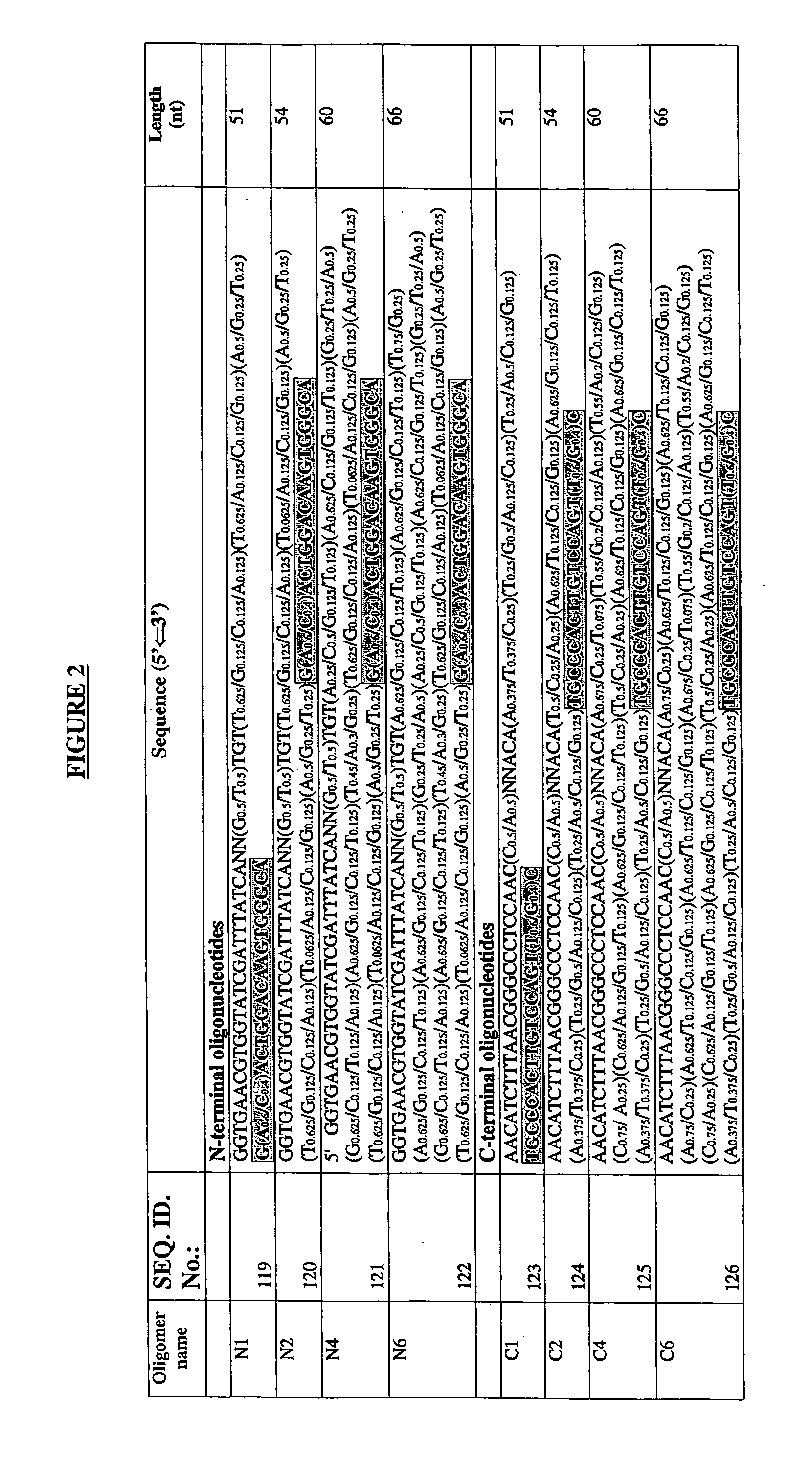Chimeric virus vaccine
a human virus and vaccine technology, applied in the field of chimeric virus vaccines, can solve the problems of lingering outbreaks, difficult production of effective and safe vaccines against harmful viruses and other pathogens, and recurring outbreaks
- Summary
- Abstract
- Description
- Claims
- Application Information
AI Technical Summary
Problems solved by technology
Method used
Image
Examples
example 1
Generation of HRV14:HIV-1 GP41 ELDKWA Libraries
[0208] Combinatorial libraries were generated in which immunogenic HIV sequences were presented on the surface of HRV, connected via linkers with variable lengths and sequences, leading to chimeric viruses displaying the HIV immunogens in myriad conformations, some resembling those of HIV. Immunoselection and competitive immunoselection procedures were used to enrich for viruses that best bind immobilized, neutralizing anti-HIV antibodies. Promising viruses were used to immunize guinea pigs and the sera and / or IgG were tested for HIV-neutralizing activity.
[0209] Immunoselected chimeric viruses were identified that were able to elicit anti-HIV neutralizing responses in vitro. Some of the purified anti-ELDKWA IgGs possessed binding activities nearly equal to those of the strongly neutralizing ELDKWA-binding mAb 2F5. In some cases, roughly 50% of the IgG present in the sera was reactive with ELDKWA peptides.
[0210] HRV14 can be used to d...
example 2
Immunoselection of HRV14:HIV-1 GP41 ELDKWA Libraries
[0218] The most antigenic pools were subjected to further immunoselection using different immunoselection approaches.
[0219] The immunoselection conditions were varied to enrich for chimeric viruses with the ELDKWA epitope transplanted in an immunologically relevant conformation. In previous work performed with chimeric rhinovirus libraries (Resnick et al., 1995; Smith et al., 1998), a direct immunoselection approach with one or more antibodies was used. In this case alternative approaches were used in order to yield pools richer in immunogenic chimeras. A preliminary screening, measuring the ability of the immunoselected virus pools and their unselected parent pools to bind mAb 2F5, was performed in order to monitor the evolution of the antigenic characteristics of the pools after each immunoselection round (using direct ELISAs).
[0220] Competitive Immunoselection.
[0221] For pool I, which consisted of members of libraries 12, 14...
example 3
Sequence Analysis of HRV14:HIV-1 GP41 ELDKWA Chimeric Viruses
[0228] Sequence analysis was performed on both unselected and immunoselected viruses, to identify important differences in amino acid residues among the different groups. On average, 10 plaques per selected pool were sequenced (FIG. 5C). It was observed that in pools where the immunoselection conditions had been very stringent, fewer unique clones were isolated, leading to a loss of diversity. An extreme case was seen with Pool I round C, from which one clone, 14-C4000-1, appeared for 10 of the 19 plaques isolated, and the actual number of unique clones identified within this particular pool was 3. Other clones from immunoselection round C using less stringent conditions were also repeated, but to a lesser degree, appearing in 2 or 3 out of 10 or 15 of the plaques isolated. After sequencing immunoselected clones from Pool I, it was decided to adjust the stringency conditions and the number of immunoselection rounds for th...
PUM
| Property | Measurement | Unit |
|---|---|---|
| temperature | aaaaa | aaaaa |
| Tm | aaaaa | aaaaa |
| pH | aaaaa | aaaaa |
Abstract
Description
Claims
Application Information
 Login to View More
Login to View More - R&D
- Intellectual Property
- Life Sciences
- Materials
- Tech Scout
- Unparalleled Data Quality
- Higher Quality Content
- 60% Fewer Hallucinations
Browse by: Latest US Patents, China's latest patents, Technical Efficacy Thesaurus, Application Domain, Technology Topic, Popular Technical Reports.
© 2025 PatSnap. All rights reserved.Legal|Privacy policy|Modern Slavery Act Transparency Statement|Sitemap|About US| Contact US: help@patsnap.com



